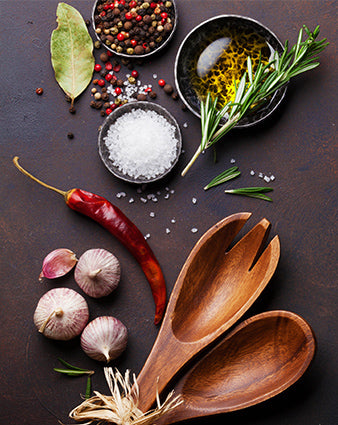From Farm-to-Fork: The Creation of Cloves 🤎
Cloves are those tiny, aromatic powerhouses that add warmth and depth to dishes and drinks worldwide. But have you ever wondered how these little wonders go from farm to fork?
Let's take a flavourful journey through the fascinating process of clove farming!
1. The Birthplace: Clove Trees 🌲 
Cloves come from a tropical evergreen native to the Maluku Islands in Indonesia, famously known as the Spice Islands. These trees thrive in warm, humid climates, where they can stretch up to 30 feet tall. With glossy green leaves and clusters of fragrant, tiny flowers, they look like Christmas trees with a hidden secret...
2. Patience, Patience: Growing Clove Trees ⏲️
Clove farming is not for the impatient. After planting, these trees take 6-8 years to mature and start producing flower buds. But once they do, they're in it for the long haul, yielding cloves for decades—sometimes even up to 80 years!
3. Budding Beauties: The Formation of Cloves 🌼
The magic begins as the rainy season approaches. Clove trees burst into bloom, with each branch adorned with clusters of pale green flower buds. These buds are the precursors to the cloves we use in our kitchens. As they mature, they slowly change colour from green to a bright red—a sign that they’re ready to be harvested.
4. The Perfect Timing: Harvesting Cloves 👨🌾
Harvesting cloves is a game of precision. The buds are handpicked just before they bloom—a narrow window that ensures they’re at their peak flavour and oil content. If the buds open into flowers, they lose their potency, so farmers must be vigilant and swift. 
5. Sun-Kissed Drying: Turning Buds into Spices 🌞
Once harvested, the fresh buds are laid out on mats under the sun. Over the course of 4-5 days, they slowly darken and harden, shrinking into the familiar nail-shaped cloves we know and love. During this time, the air is filled with the unmistakable, heady aroma of cloves—a scent that signals the transformation from fresh bud to spice.
6. Quality Assurance: The Sink or Swim Test 👩🔬
Farmers have a neat trick to ensure they’re offering the best cloves: the floating test. High-quality cloves are rich in essential oils, making them dense enough to sink in water. If a clove floats, it's considered less desirable. So, next time you’re cooking with cloves, know that the ones that sink are the spice world’s elite!
7. From Farm to Market: The Journey Continues 📦
After drying and sorting, the cloves are ready to embark on their global journey. They’re packed and shipped off ready to add their distinctive warmth to cuisines from around the world. Whether it’s a Moroccan tagine, an Indian biryani, or a European mulled wine, cloves bring their unmistakable aroma and flavour to dishes across continents.
8. Fork Time: Cooking with Cloves 👩🍳
When cloves finally reach your kitchen, they’re ready to work their magic. Whole or ground, cloves are a versatile spice. They can add a subtle warmth to sweet treats like pumpkin pie and gingerbread, or bring a spicy kick to savory dishes like curries and stews. And let’s not forget their star role in holiday classics like mulled wine and spiced cider.
The Final Pinch 🍴
Clove farming is a labour of love, involving years of patience, precise timing, and a deep connection to nature. The next time you use cloves in your cooking, take a moment to appreciate the journey they’ve been on—from a tropical tree in the Spice Islands to the spice rack in your kitchen.
It's a small but flavourful reminder of the global journey our food takes to reach our tables...
Spice Fun Fact: Did you know that cloves were once so valuable that their value was equivalent to gold? In the 16th century, European traders went to extreme lengths to control clove production, including burning clove trees to maintain their monopoly!







